Strategic Performance Measurement System Report for MNCs
VerifiedAdded on 2021/06/17
|11
|2405
|41
Report
AI Summary
This report provides a comprehensive analysis of the Strategic Performance Measurement System (SPMS), particularly within multinational corporations (MNCs). It begins by defining the nature of SPMS, emphasizing its role in linking employee performance with organizational goals and its connection to strategic alignment. The report then delves into the challenges of implementing SPMS in MNCs, highlighting issues such as differing goals between subsidiaries and parent companies, difficulties in performance evaluation due to international contexts, and the impact of cultural diversity on performance measurement. The report further discusses the implications of SPMS on strategic alignment, emphasizing the importance of information quality and the Balanced Scorecard in motivating employees and promoting strategic alignment. The report concludes by summarizing the key findings, emphasizing the complexities of SPMS implementation in multinational settings and the importance of considering cultural and organizational factors for effective performance measurement.

Running head: STRATEGIC PERFORMANCE MEASUREMENT SYSTEM
Strategic Performance Measurement System
Name of the student
Name of the University
Author note
Strategic Performance Measurement System
Name of the student
Name of the University
Author note
Paraphrase This Document
Need a fresh take? Get an instant paraphrase of this document with our AI Paraphraser

1STRATEGIC PERFORMANCE MEASUREMENT SYSTEM
Executive Summary
The primary purpose of this report is to discuss about the strategic performance measurement
system of multinational organisations. It elaborates on the issues related to that of strategic
performance measurement system for the multinational corporations. It discusses about the
nature of strategic performance measurement system and its implications on the aspect of
strategic alignment.
Executive Summary
The primary purpose of this report is to discuss about the strategic performance measurement
system of multinational organisations. It elaborates on the issues related to that of strategic
performance measurement system for the multinational corporations. It discusses about the
nature of strategic performance measurement system and its implications on the aspect of
strategic alignment.
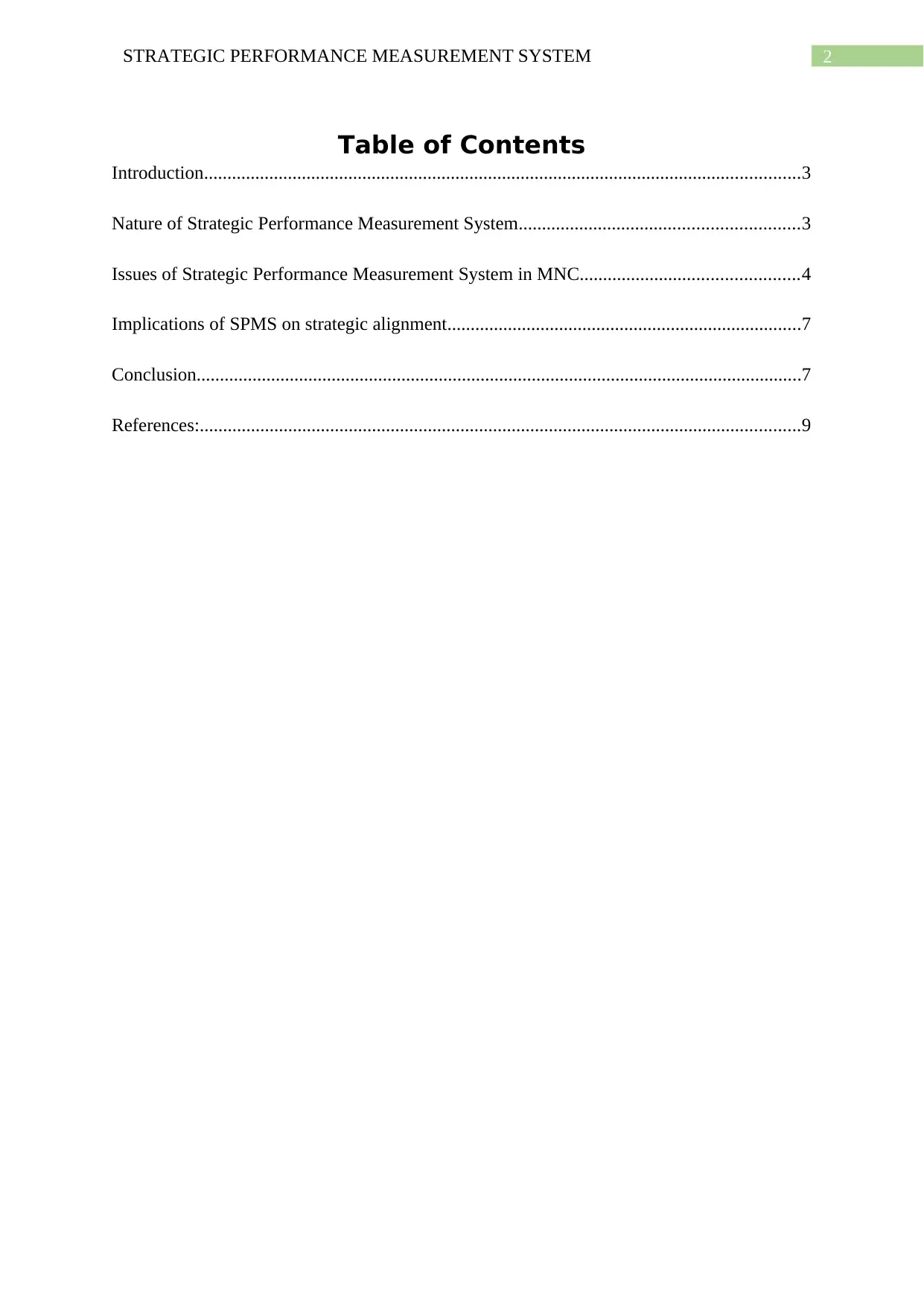
2STRATEGIC PERFORMANCE MEASUREMENT SYSTEM
Table of Contents
Introduction................................................................................................................................3
Nature of Strategic Performance Measurement System............................................................3
Issues of Strategic Performance Measurement System in MNC...............................................4
Implications of SPMS on strategic alignment............................................................................7
Conclusion..................................................................................................................................7
References:.................................................................................................................................9
Table of Contents
Introduction................................................................................................................................3
Nature of Strategic Performance Measurement System............................................................3
Issues of Strategic Performance Measurement System in MNC...............................................4
Implications of SPMS on strategic alignment............................................................................7
Conclusion..................................................................................................................................7
References:.................................................................................................................................9
⊘ This is a preview!⊘
Do you want full access?
Subscribe today to unlock all pages.

Trusted by 1+ million students worldwide
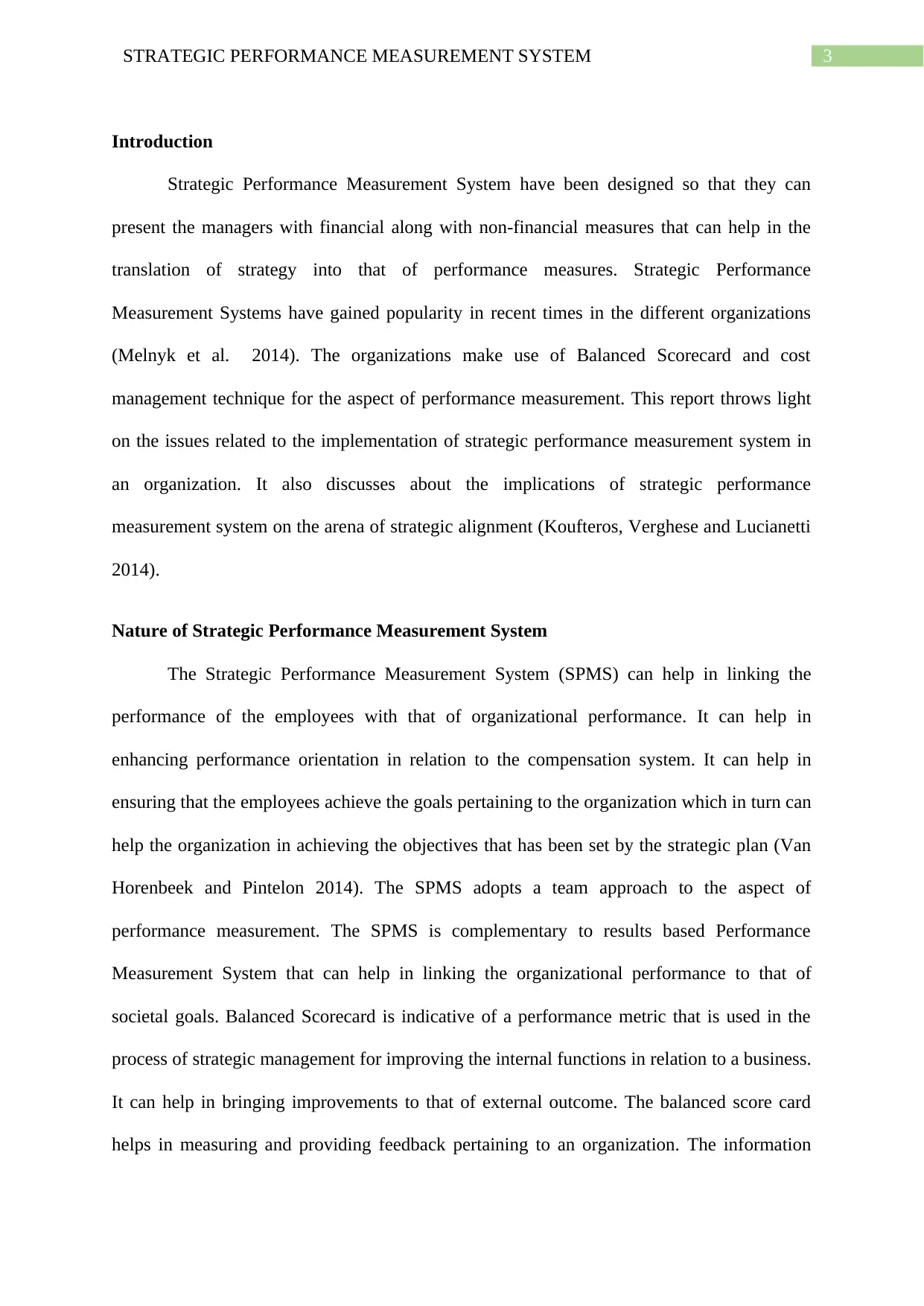
3STRATEGIC PERFORMANCE MEASUREMENT SYSTEM
Introduction
Strategic Performance Measurement System have been designed so that they can
present the managers with financial along with non-financial measures that can help in the
translation of strategy into that of performance measures. Strategic Performance
Measurement Systems have gained popularity in recent times in the different organizations
(Melnyk et al. 2014). The organizations make use of Balanced Scorecard and cost
management technique for the aspect of performance measurement. This report throws light
on the issues related to the implementation of strategic performance measurement system in
an organization. It also discusses about the implications of strategic performance
measurement system on the arena of strategic alignment (Koufteros, Verghese and Lucianetti
2014).
Nature of Strategic Performance Measurement System
The Strategic Performance Measurement System (SPMS) can help in linking the
performance of the employees with that of organizational performance. It can help in
enhancing performance orientation in relation to the compensation system. It can help in
ensuring that the employees achieve the goals pertaining to the organization which in turn can
help the organization in achieving the objectives that has been set by the strategic plan (Van
Horenbeek and Pintelon 2014). The SPMS adopts a team approach to the aspect of
performance measurement. The SPMS is complementary to results based Performance
Measurement System that can help in linking the organizational performance to that of
societal goals. Balanced Scorecard is indicative of a performance metric that is used in the
process of strategic management for improving the internal functions in relation to a business.
It can help in bringing improvements to that of external outcome. The balanced score card
helps in measuring and providing feedback pertaining to an organization. The information
Introduction
Strategic Performance Measurement System have been designed so that they can
present the managers with financial along with non-financial measures that can help in the
translation of strategy into that of performance measures. Strategic Performance
Measurement Systems have gained popularity in recent times in the different organizations
(Melnyk et al. 2014). The organizations make use of Balanced Scorecard and cost
management technique for the aspect of performance measurement. This report throws light
on the issues related to the implementation of strategic performance measurement system in
an organization. It also discusses about the implications of strategic performance
measurement system on the arena of strategic alignment (Koufteros, Verghese and Lucianetti
2014).
Nature of Strategic Performance Measurement System
The Strategic Performance Measurement System (SPMS) can help in linking the
performance of the employees with that of organizational performance. It can help in
enhancing performance orientation in relation to the compensation system. It can help in
ensuring that the employees achieve the goals pertaining to the organization which in turn can
help the organization in achieving the objectives that has been set by the strategic plan (Van
Horenbeek and Pintelon 2014). The SPMS adopts a team approach to the aspect of
performance measurement. The SPMS is complementary to results based Performance
Measurement System that can help in linking the organizational performance to that of
societal goals. Balanced Scorecard is indicative of a performance metric that is used in the
process of strategic management for improving the internal functions in relation to a business.
It can help in bringing improvements to that of external outcome. The balanced score card
helps in measuring and providing feedback pertaining to an organization. The information
Paraphrase This Document
Need a fresh take? Get an instant paraphrase of this document with our AI Paraphraser
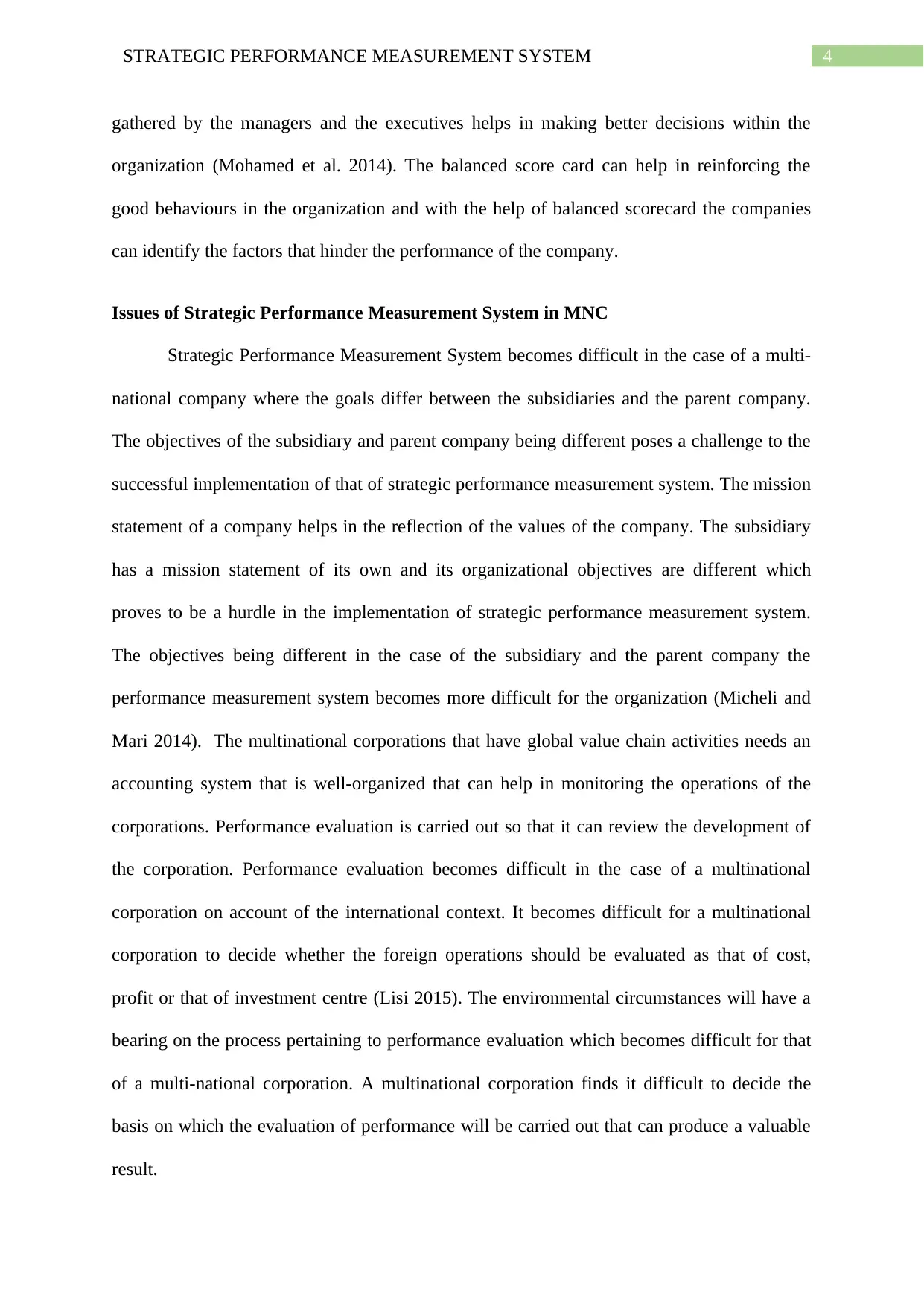
4STRATEGIC PERFORMANCE MEASUREMENT SYSTEM
gathered by the managers and the executives helps in making better decisions within the
organization (Mohamed et al. 2014). The balanced score card can help in reinforcing the
good behaviours in the organization and with the help of balanced scorecard the companies
can identify the factors that hinder the performance of the company.
Issues of Strategic Performance Measurement System in MNC
Strategic Performance Measurement System becomes difficult in the case of a multi-
national company where the goals differ between the subsidiaries and the parent company.
The objectives of the subsidiary and parent company being different poses a challenge to the
successful implementation of that of strategic performance measurement system. The mission
statement of a company helps in the reflection of the values of the company. The subsidiary
has a mission statement of its own and its organizational objectives are different which
proves to be a hurdle in the implementation of strategic performance measurement system.
The objectives being different in the case of the subsidiary and the parent company the
performance measurement system becomes more difficult for the organization (Micheli and
Mari 2014). The multinational corporations that have global value chain activities needs an
accounting system that is well-organized that can help in monitoring the operations of the
corporations. Performance evaluation is carried out so that it can review the development of
the corporation. Performance evaluation becomes difficult in the case of a multinational
corporation on account of the international context. It becomes difficult for a multinational
corporation to decide whether the foreign operations should be evaluated as that of cost,
profit or that of investment centre (Lisi 2015). The environmental circumstances will have a
bearing on the process pertaining to performance evaluation which becomes difficult for that
of a multi-national corporation. A multinational corporation finds it difficult to decide the
basis on which the evaluation of performance will be carried out that can produce a valuable
result.
gathered by the managers and the executives helps in making better decisions within the
organization (Mohamed et al. 2014). The balanced score card can help in reinforcing the
good behaviours in the organization and with the help of balanced scorecard the companies
can identify the factors that hinder the performance of the company.
Issues of Strategic Performance Measurement System in MNC
Strategic Performance Measurement System becomes difficult in the case of a multi-
national company where the goals differ between the subsidiaries and the parent company.
The objectives of the subsidiary and parent company being different poses a challenge to the
successful implementation of that of strategic performance measurement system. The mission
statement of a company helps in the reflection of the values of the company. The subsidiary
has a mission statement of its own and its organizational objectives are different which
proves to be a hurdle in the implementation of strategic performance measurement system.
The objectives being different in the case of the subsidiary and the parent company the
performance measurement system becomes more difficult for the organization (Micheli and
Mari 2014). The multinational corporations that have global value chain activities needs an
accounting system that is well-organized that can help in monitoring the operations of the
corporations. Performance evaluation is carried out so that it can review the development of
the corporation. Performance evaluation becomes difficult in the case of a multinational
corporation on account of the international context. It becomes difficult for a multinational
corporation to decide whether the foreign operations should be evaluated as that of cost,
profit or that of investment centre (Lisi 2015). The environmental circumstances will have a
bearing on the process pertaining to performance evaluation which becomes difficult for that
of a multi-national corporation. A multinational corporation finds it difficult to decide the
basis on which the evaluation of performance will be carried out that can produce a valuable
result.
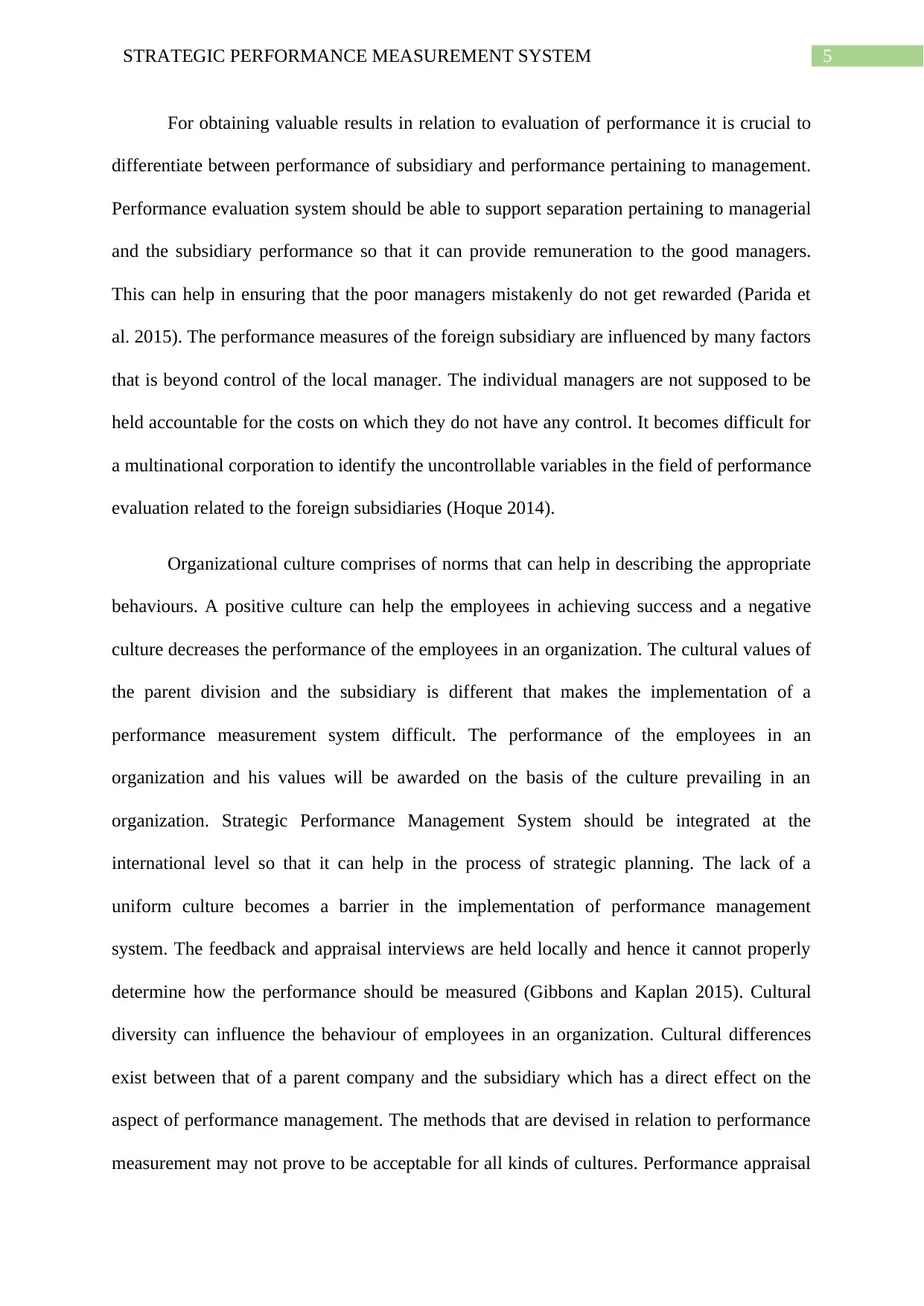
5STRATEGIC PERFORMANCE MEASUREMENT SYSTEM
For obtaining valuable results in relation to evaluation of performance it is crucial to
differentiate between performance of subsidiary and performance pertaining to management.
Performance evaluation system should be able to support separation pertaining to managerial
and the subsidiary performance so that it can provide remuneration to the good managers.
This can help in ensuring that the poor managers mistakenly do not get rewarded (Parida et
al. 2015). The performance measures of the foreign subsidiary are influenced by many factors
that is beyond control of the local manager. The individual managers are not supposed to be
held accountable for the costs on which they do not have any control. It becomes difficult for
a multinational corporation to identify the uncontrollable variables in the field of performance
evaluation related to the foreign subsidiaries (Hoque 2014).
Organizational culture comprises of norms that can help in describing the appropriate
behaviours. A positive culture can help the employees in achieving success and a negative
culture decreases the performance of the employees in an organization. The cultural values of
the parent division and the subsidiary is different that makes the implementation of a
performance measurement system difficult. The performance of the employees in an
organization and his values will be awarded on the basis of the culture prevailing in an
organization. Strategic Performance Management System should be integrated at the
international level so that it can help in the process of strategic planning. The lack of a
uniform culture becomes a barrier in the implementation of performance management
system. The feedback and appraisal interviews are held locally and hence it cannot properly
determine how the performance should be measured (Gibbons and Kaplan 2015). Cultural
diversity can influence the behaviour of employees in an organization. Cultural differences
exist between that of a parent company and the subsidiary which has a direct effect on the
aspect of performance management. The methods that are devised in relation to performance
measurement may not prove to be acceptable for all kinds of cultures. Performance appraisal
For obtaining valuable results in relation to evaluation of performance it is crucial to
differentiate between performance of subsidiary and performance pertaining to management.
Performance evaluation system should be able to support separation pertaining to managerial
and the subsidiary performance so that it can provide remuneration to the good managers.
This can help in ensuring that the poor managers mistakenly do not get rewarded (Parida et
al. 2015). The performance measures of the foreign subsidiary are influenced by many factors
that is beyond control of the local manager. The individual managers are not supposed to be
held accountable for the costs on which they do not have any control. It becomes difficult for
a multinational corporation to identify the uncontrollable variables in the field of performance
evaluation related to the foreign subsidiaries (Hoque 2014).
Organizational culture comprises of norms that can help in describing the appropriate
behaviours. A positive culture can help the employees in achieving success and a negative
culture decreases the performance of the employees in an organization. The cultural values of
the parent division and the subsidiary is different that makes the implementation of a
performance measurement system difficult. The performance of the employees in an
organization and his values will be awarded on the basis of the culture prevailing in an
organization. Strategic Performance Management System should be integrated at the
international level so that it can help in the process of strategic planning. The lack of a
uniform culture becomes a barrier in the implementation of performance management
system. The feedback and appraisal interviews are held locally and hence it cannot properly
determine how the performance should be measured (Gibbons and Kaplan 2015). Cultural
diversity can influence the behaviour of employees in an organization. Cultural differences
exist between that of a parent company and the subsidiary which has a direct effect on the
aspect of performance management. The methods that are devised in relation to performance
measurement may not prove to be acceptable for all kinds of cultures. Performance appraisal
⊘ This is a preview!⊘
Do you want full access?
Subscribe today to unlock all pages.

Trusted by 1+ million students worldwide
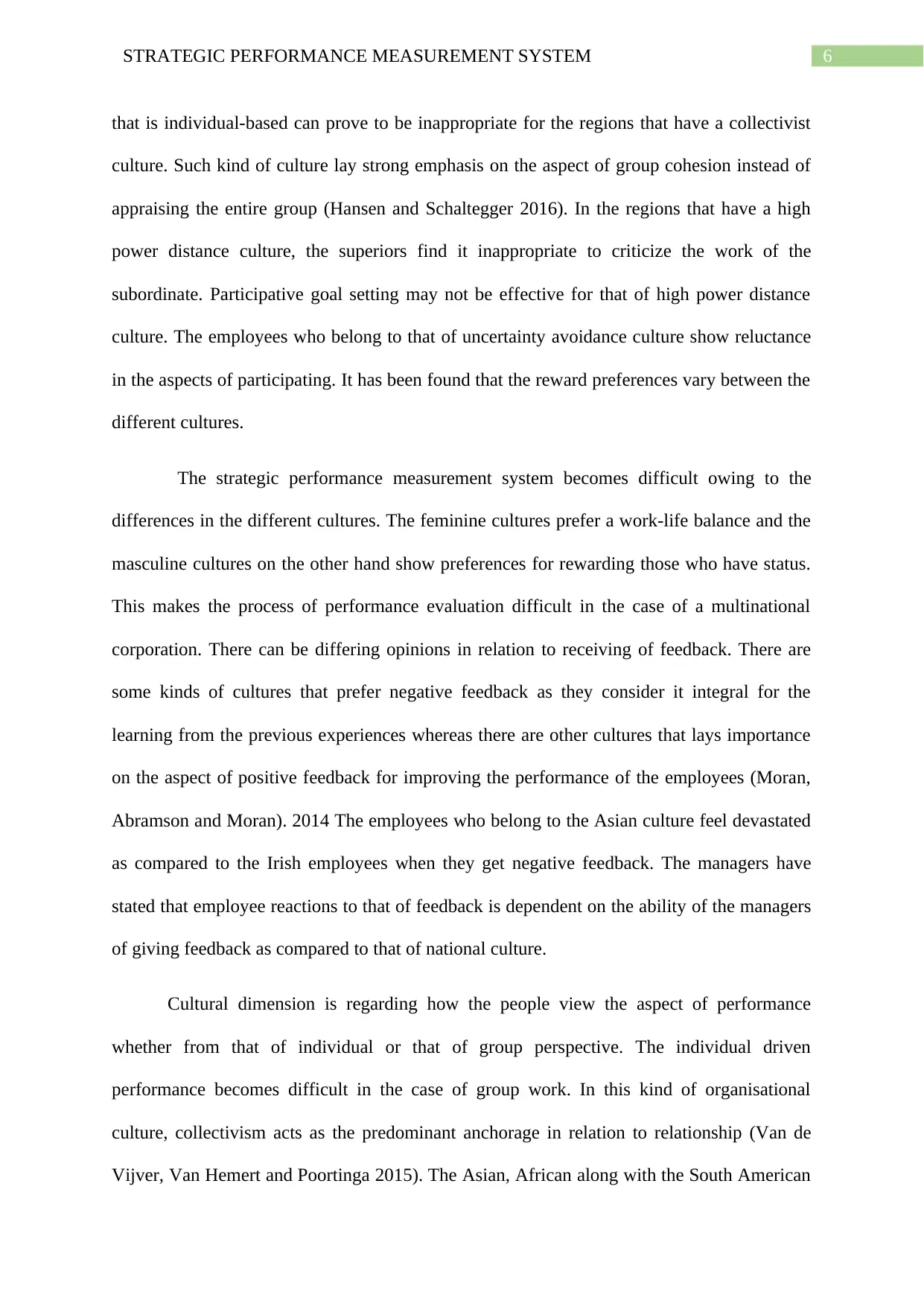
6STRATEGIC PERFORMANCE MEASUREMENT SYSTEM
that is individual-based can prove to be inappropriate for the regions that have a collectivist
culture. Such kind of culture lay strong emphasis on the aspect of group cohesion instead of
appraising the entire group (Hansen and Schaltegger 2016). In the regions that have a high
power distance culture, the superiors find it inappropriate to criticize the work of the
subordinate. Participative goal setting may not be effective for that of high power distance
culture. The employees who belong to that of uncertainty avoidance culture show reluctance
in the aspects of participating. It has been found that the reward preferences vary between the
different cultures.
The strategic performance measurement system becomes difficult owing to the
differences in the different cultures. The feminine cultures prefer a work-life balance and the
masculine cultures on the other hand show preferences for rewarding those who have status.
This makes the process of performance evaluation difficult in the case of a multinational
corporation. There can be differing opinions in relation to receiving of feedback. There are
some kinds of cultures that prefer negative feedback as they consider it integral for the
learning from the previous experiences whereas there are other cultures that lays importance
on the aspect of positive feedback for improving the performance of the employees (Moran,
Abramson and Moran). 2014 The employees who belong to the Asian culture feel devastated
as compared to the Irish employees when they get negative feedback. The managers have
stated that employee reactions to that of feedback is dependent on the ability of the managers
of giving feedback as compared to that of national culture.
Cultural dimension is regarding how the people view the aspect of performance
whether from that of individual or that of group perspective. The individual driven
performance becomes difficult in the case of group work. In this kind of organisational
culture, collectivism acts as the predominant anchorage in relation to relationship (Van de
Vijver, Van Hemert and Poortinga 2015). The Asian, African along with the South American
that is individual-based can prove to be inappropriate for the regions that have a collectivist
culture. Such kind of culture lay strong emphasis on the aspect of group cohesion instead of
appraising the entire group (Hansen and Schaltegger 2016). In the regions that have a high
power distance culture, the superiors find it inappropriate to criticize the work of the
subordinate. Participative goal setting may not be effective for that of high power distance
culture. The employees who belong to that of uncertainty avoidance culture show reluctance
in the aspects of participating. It has been found that the reward preferences vary between the
different cultures.
The strategic performance measurement system becomes difficult owing to the
differences in the different cultures. The feminine cultures prefer a work-life balance and the
masculine cultures on the other hand show preferences for rewarding those who have status.
This makes the process of performance evaluation difficult in the case of a multinational
corporation. There can be differing opinions in relation to receiving of feedback. There are
some kinds of cultures that prefer negative feedback as they consider it integral for the
learning from the previous experiences whereas there are other cultures that lays importance
on the aspect of positive feedback for improving the performance of the employees (Moran,
Abramson and Moran). 2014 The employees who belong to the Asian culture feel devastated
as compared to the Irish employees when they get negative feedback. The managers have
stated that employee reactions to that of feedback is dependent on the ability of the managers
of giving feedback as compared to that of national culture.
Cultural dimension is regarding how the people view the aspect of performance
whether from that of individual or that of group perspective. The individual driven
performance becomes difficult in the case of group work. In this kind of organisational
culture, collectivism acts as the predominant anchorage in relation to relationship (Van de
Vijver, Van Hemert and Poortinga 2015). The Asian, African along with the South American
Paraphrase This Document
Need a fresh take? Get an instant paraphrase of this document with our AI Paraphraser
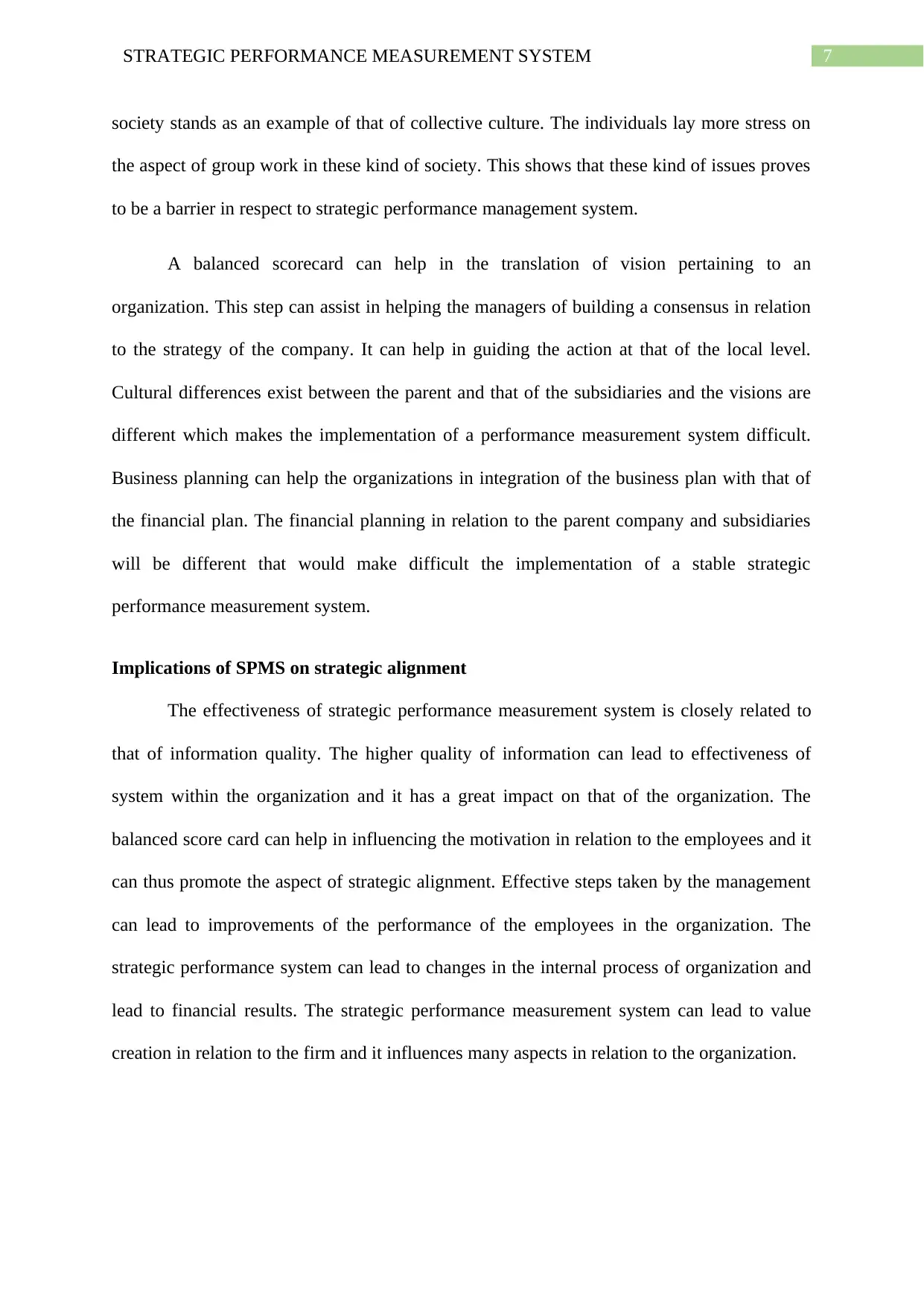
7STRATEGIC PERFORMANCE MEASUREMENT SYSTEM
society stands as an example of that of collective culture. The individuals lay more stress on
the aspect of group work in these kind of society. This shows that these kind of issues proves
to be a barrier in respect to strategic performance management system.
A balanced scorecard can help in the translation of vision pertaining to an
organization. This step can assist in helping the managers of building a consensus in relation
to the strategy of the company. It can help in guiding the action at that of the local level.
Cultural differences exist between the parent and that of the subsidiaries and the visions are
different which makes the implementation of a performance measurement system difficult.
Business planning can help the organizations in integration of the business plan with that of
the financial plan. The financial planning in relation to the parent company and subsidiaries
will be different that would make difficult the implementation of a stable strategic
performance measurement system.
Implications of SPMS on strategic alignment
The effectiveness of strategic performance measurement system is closely related to
that of information quality. The higher quality of information can lead to effectiveness of
system within the organization and it has a great impact on that of the organization. The
balanced score card can help in influencing the motivation in relation to the employees and it
can thus promote the aspect of strategic alignment. Effective steps taken by the management
can lead to improvements of the performance of the employees in the organization. The
strategic performance system can lead to changes in the internal process of organization and
lead to financial results. The strategic performance measurement system can lead to value
creation in relation to the firm and it influences many aspects in relation to the organization.
society stands as an example of that of collective culture. The individuals lay more stress on
the aspect of group work in these kind of society. This shows that these kind of issues proves
to be a barrier in respect to strategic performance management system.
A balanced scorecard can help in the translation of vision pertaining to an
organization. This step can assist in helping the managers of building a consensus in relation
to the strategy of the company. It can help in guiding the action at that of the local level.
Cultural differences exist between the parent and that of the subsidiaries and the visions are
different which makes the implementation of a performance measurement system difficult.
Business planning can help the organizations in integration of the business plan with that of
the financial plan. The financial planning in relation to the parent company and subsidiaries
will be different that would make difficult the implementation of a stable strategic
performance measurement system.
Implications of SPMS on strategic alignment
The effectiveness of strategic performance measurement system is closely related to
that of information quality. The higher quality of information can lead to effectiveness of
system within the organization and it has a great impact on that of the organization. The
balanced score card can help in influencing the motivation in relation to the employees and it
can thus promote the aspect of strategic alignment. Effective steps taken by the management
can lead to improvements of the performance of the employees in the organization. The
strategic performance system can lead to changes in the internal process of organization and
lead to financial results. The strategic performance measurement system can lead to value
creation in relation to the firm and it influences many aspects in relation to the organization.
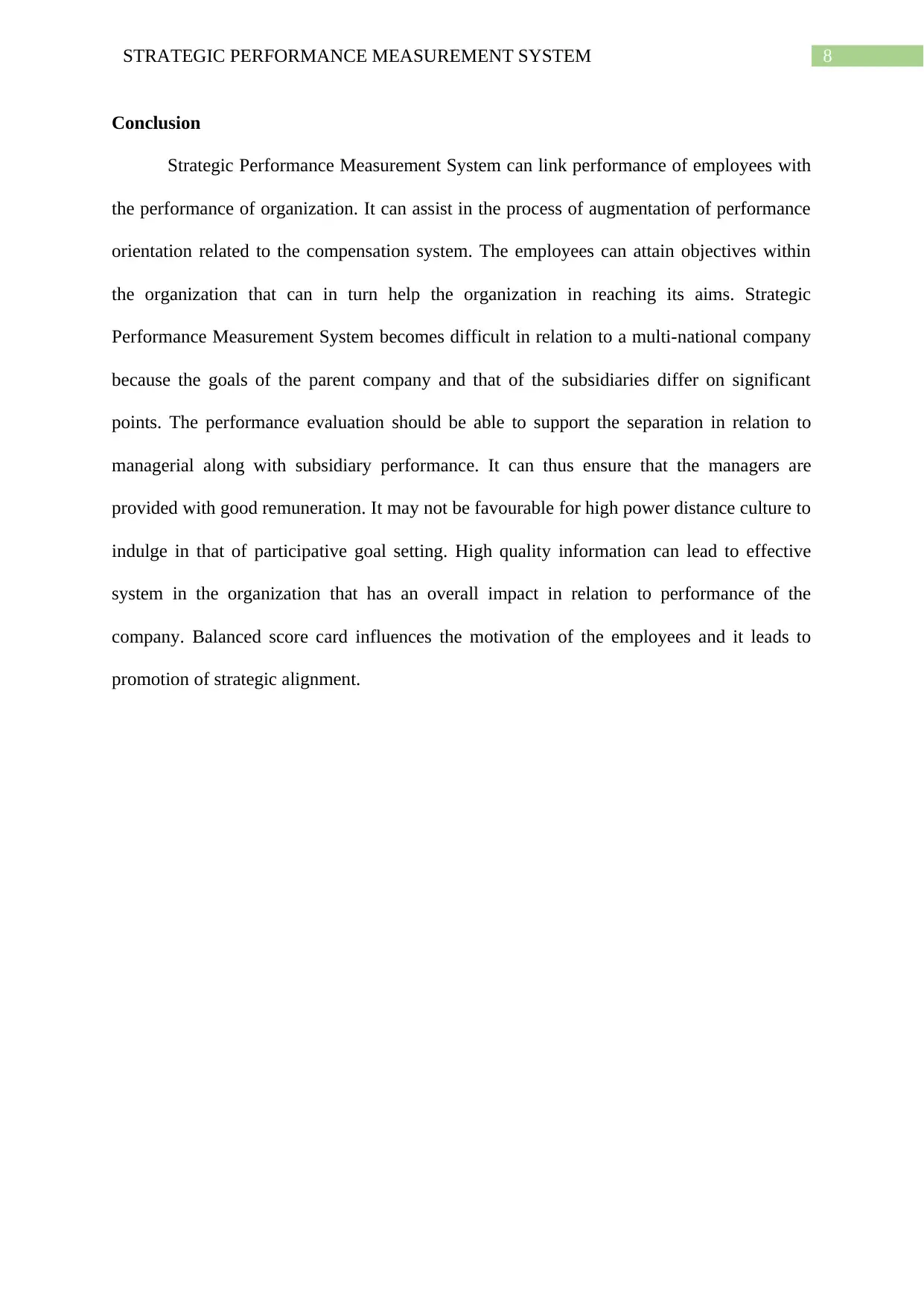
8STRATEGIC PERFORMANCE MEASUREMENT SYSTEM
Conclusion
Strategic Performance Measurement System can link performance of employees with
the performance of organization. It can assist in the process of augmentation of performance
orientation related to the compensation system. The employees can attain objectives within
the organization that can in turn help the organization in reaching its aims. Strategic
Performance Measurement System becomes difficult in relation to a multi-national company
because the goals of the parent company and that of the subsidiaries differ on significant
points. The performance evaluation should be able to support the separation in relation to
managerial along with subsidiary performance. It can thus ensure that the managers are
provided with good remuneration. It may not be favourable for high power distance culture to
indulge in that of participative goal setting. High quality information can lead to effective
system in the organization that has an overall impact in relation to performance of the
company. Balanced score card influences the motivation of the employees and it leads to
promotion of strategic alignment.
Conclusion
Strategic Performance Measurement System can link performance of employees with
the performance of organization. It can assist in the process of augmentation of performance
orientation related to the compensation system. The employees can attain objectives within
the organization that can in turn help the organization in reaching its aims. Strategic
Performance Measurement System becomes difficult in relation to a multi-national company
because the goals of the parent company and that of the subsidiaries differ on significant
points. The performance evaluation should be able to support the separation in relation to
managerial along with subsidiary performance. It can thus ensure that the managers are
provided with good remuneration. It may not be favourable for high power distance culture to
indulge in that of participative goal setting. High quality information can lead to effective
system in the organization that has an overall impact in relation to performance of the
company. Balanced score card influences the motivation of the employees and it leads to
promotion of strategic alignment.
⊘ This is a preview!⊘
Do you want full access?
Subscribe today to unlock all pages.

Trusted by 1+ million students worldwide

9STRATEGIC PERFORMANCE MEASUREMENT SYSTEM
References:
Gibbons, R. and Kaplan, R.S., 2015. Formal Measures in Informal Management: Can a
Balanced Scorecard Change a Culture?. American Economic Review, 105(5), pp.447-51.
Hansen, E.G. and Schaltegger, S., 2016. The sustainability balanced scorecard: A systematic
review of architectures. Journal of Business Ethics, 133(2), pp.193-221.
Hoque, Z., 2014. 20 years of studies on the balanced scorecard: trends, accomplishments,
gaps and opportunities for future research. The British accounting review, 46(1), pp.33-59.
Koufteros, X., Verghese, A.J. and Lucianetti, L., 2014. The effect of performance
measurement systems on firm performance: A cross-sectional and a longitudinal
study. Journal of Operations Management, 32(6), pp.313-336.
Lisi, I.E., 2015. Translating environmental motivations into performance: The role of
environmental performance measurement systems. Management Accounting Research, 29,
pp.27-44.
Melnyk, S.A., Bititci, U., Platts, K., Tobias, J. and Andersen, B., 2014. Is performance
measurement and management fit for the future?. Management Accounting Research, 25(2),
pp.173-186.
Micheli, P. and Mari, L., 2014. The theory and practice of performance
measurement. Management accounting research, 25(2), pp.147-156.
Mohamed, R., Wee, S.H., Rahman, I.K.A. and Aziz, R.A., 2014. The relationship between
strategic performance measurement system and organisational capabilities: The role of beliefs
and boundary control systems. Asian Journal of business and Accounting, 7(1).
Moran, R.T., Abramson, N.R. and Moran, S.V., 2014. Managing cultural differences.
Routledge.
References:
Gibbons, R. and Kaplan, R.S., 2015. Formal Measures in Informal Management: Can a
Balanced Scorecard Change a Culture?. American Economic Review, 105(5), pp.447-51.
Hansen, E.G. and Schaltegger, S., 2016. The sustainability balanced scorecard: A systematic
review of architectures. Journal of Business Ethics, 133(2), pp.193-221.
Hoque, Z., 2014. 20 years of studies on the balanced scorecard: trends, accomplishments,
gaps and opportunities for future research. The British accounting review, 46(1), pp.33-59.
Koufteros, X., Verghese, A.J. and Lucianetti, L., 2014. The effect of performance
measurement systems on firm performance: A cross-sectional and a longitudinal
study. Journal of Operations Management, 32(6), pp.313-336.
Lisi, I.E., 2015. Translating environmental motivations into performance: The role of
environmental performance measurement systems. Management Accounting Research, 29,
pp.27-44.
Melnyk, S.A., Bititci, U., Platts, K., Tobias, J. and Andersen, B., 2014. Is performance
measurement and management fit for the future?. Management Accounting Research, 25(2),
pp.173-186.
Micheli, P. and Mari, L., 2014. The theory and practice of performance
measurement. Management accounting research, 25(2), pp.147-156.
Mohamed, R., Wee, S.H., Rahman, I.K.A. and Aziz, R.A., 2014. The relationship between
strategic performance measurement system and organisational capabilities: The role of beliefs
and boundary control systems. Asian Journal of business and Accounting, 7(1).
Moran, R.T., Abramson, N.R. and Moran, S.V., 2014. Managing cultural differences.
Routledge.
Paraphrase This Document
Need a fresh take? Get an instant paraphrase of this document with our AI Paraphraser
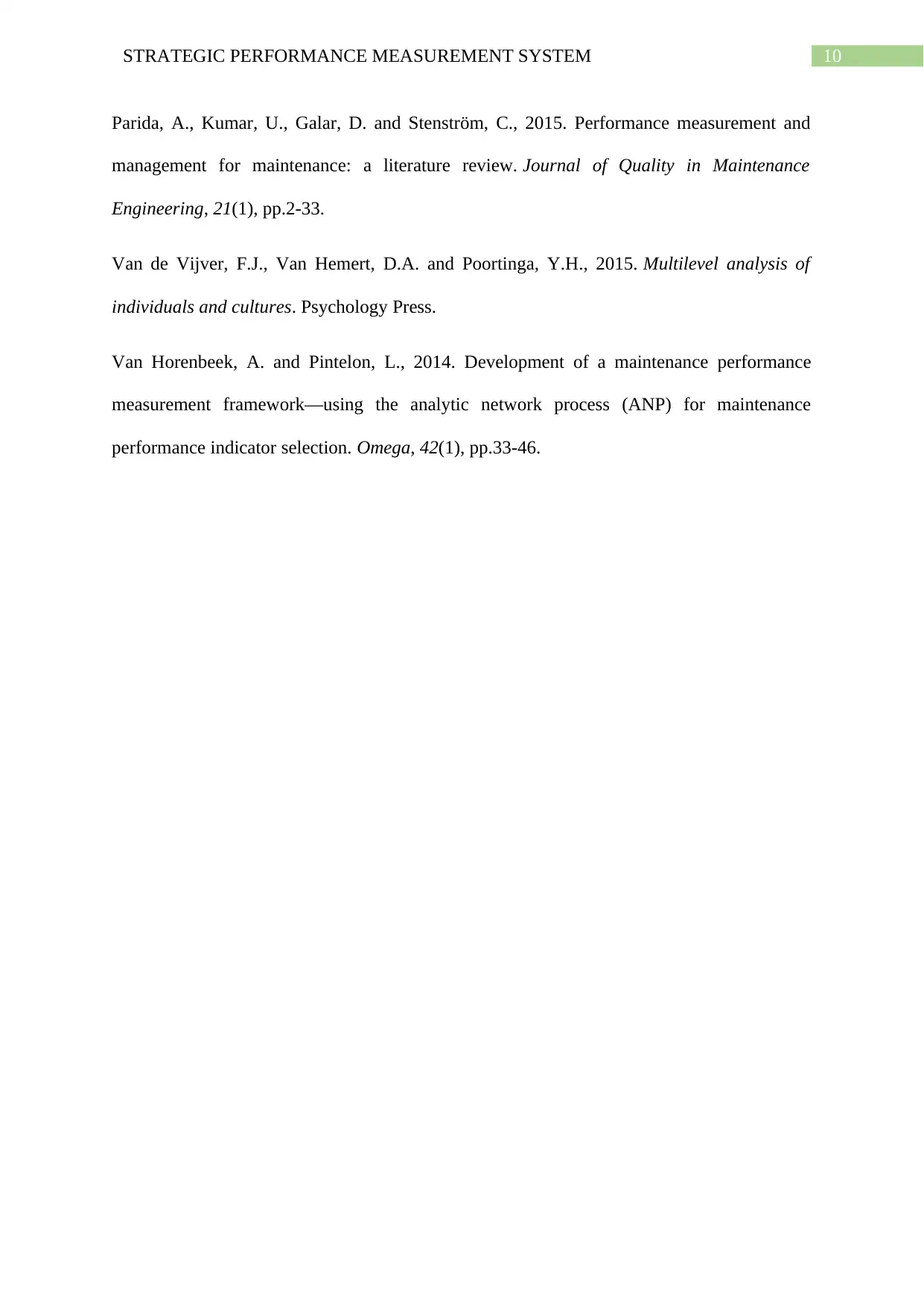
10STRATEGIC PERFORMANCE MEASUREMENT SYSTEM
Parida, A., Kumar, U., Galar, D. and Stenström, C., 2015. Performance measurement and
management for maintenance: a literature review. Journal of Quality in Maintenance
Engineering, 21(1), pp.2-33.
Van de Vijver, F.J., Van Hemert, D.A. and Poortinga, Y.H., 2015. Multilevel analysis of
individuals and cultures. Psychology Press.
Van Horenbeek, A. and Pintelon, L., 2014. Development of a maintenance performance
measurement framework—using the analytic network process (ANP) for maintenance
performance indicator selection. Omega, 42(1), pp.33-46.
Parida, A., Kumar, U., Galar, D. and Stenström, C., 2015. Performance measurement and
management for maintenance: a literature review. Journal of Quality in Maintenance
Engineering, 21(1), pp.2-33.
Van de Vijver, F.J., Van Hemert, D.A. and Poortinga, Y.H., 2015. Multilevel analysis of
individuals and cultures. Psychology Press.
Van Horenbeek, A. and Pintelon, L., 2014. Development of a maintenance performance
measurement framework—using the analytic network process (ANP) for maintenance
performance indicator selection. Omega, 42(1), pp.33-46.
1 out of 11
Related Documents
Your All-in-One AI-Powered Toolkit for Academic Success.
+13062052269
info@desklib.com
Available 24*7 on WhatsApp / Email
![[object Object]](/_next/static/media/star-bottom.7253800d.svg)
Unlock your academic potential
Copyright © 2020–2025 A2Z Services. All Rights Reserved. Developed and managed by ZUCOL.





